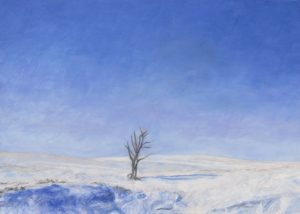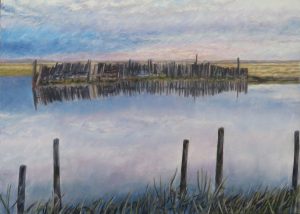
How to paint a landscape? There’s a line in an old cookbook, in a recipe for rabbit stew: “First, catch your hare.” Maybe it’s the same with landscape painting. First, catch your landscape.
I started wondering how to paint Grasslands landscape the month I moved here, to Val Marie, SK, gateway to Grasslands National Park, in late 2009. I’d never been a landscape painter. Oh, I’d painted land forms as background. For people, flora, objects of various kinds. I’d never painted them without some other purpose to tie them to. But here I was living near one of the most beautiful landscapes in the country, and walking in it often, and wanting to understand it. For me, understanding means describing, in pictures or words. I began to wonder if there was a way to paint my way into a closer relationship with this place.

I paint from photographs. Maybe if I could see this new world with the camera’s lens, I could see it with my own eyes. So a camera began to accompany me on my walks. I loved the walking. I loved the photographs. Sky, horizon, Earth. I was seeing someone else’s idea of what was in that space, and it was wonderful space.
But there were no paintings in those images.
If at first…I tried to see things differently. If photographing the broad vista didn’t work, I’d try photographing the very immediate. I lay on my stomach and photographed foreground. Lichen-covered rocks. Grasslands plants. I even took a symbolic-looking silk rose into the park and tried to see this new world as I had seen a previous one. It made cute photos with no meaning at all.
I didn’t stop thinking about Grasslands landscapes, though. Not knowing how to catch a hare doesn’t mean you don’t want rabbit stew. Then one day in 2012 I was flipping through an Irish art magazine and saw a reproduction of a painting by Padraig McCaul. He’s an Irish artist, and his work looks nothing like mine. But I saw it, and I thought, “That’s it.” I didn’t know what “it” was, but I knew I’d caught my Grasslands landscape.

So I painted one tiny picture. Colours, brushstrokes, apply and repeat. Then I painted two more. After the first three, I knew what I’d caught. From time to time, in between other projects, it’s come back to my hand and I’ve continued to explore it through my brush.
Those other projects – they’re very different from my Grasslands landscape. They’re about a human construction of beauty, how we perceive it, the constraints we put on it, and how that affects the way we interact with it.
Grasslands landscape isn’t like those images. It has no intrinsic emotion. It has space, enormous natural forms, wild weather. Its force is there whether we respond to it or not, and it has any kind of intensity it wants to on any given day. To catch it, I had needed to let the landscape be itself. That’s what McCaul had done. That’s what “it” was.

Which I guess is how you catch a landscape. Let it be itself. Don’t try too hard. Let it come to you. How to paint one? Make sure your paints are ready when it gets close.
*****
This article was originally published as a blog post in 2015 and has been updated for 2021. If you’d like to know when more articles for your artistic inspiration are published, please click here.